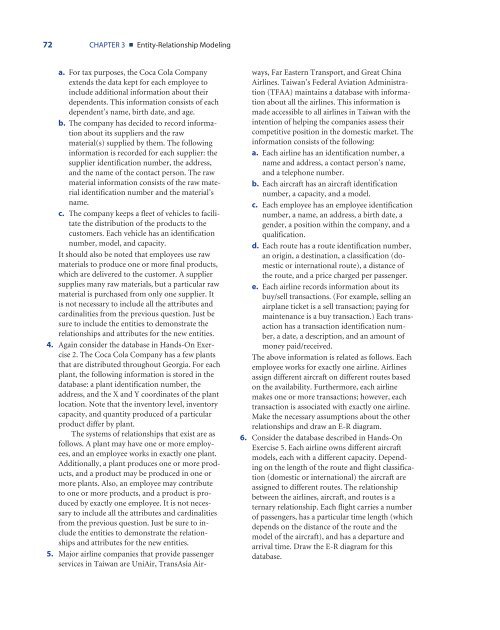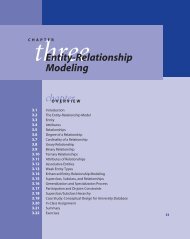Web-DSS-Chapter-03
Web-DSS-Chapter-03
Web-DSS-Chapter-03
Create successful ePaper yourself
Turn your PDF publications into a flip-book with our unique Google optimized e-Paper software.
72 CHAPTER 3 ■ Entity-Relationship Modeling<br />
a. For tax purposes, the Coca Cola Company<br />
extends the data kept for each employee to<br />
include additional information about their<br />
dependents. This information consists of each<br />
dependent’s name, birth date, and age.<br />
b. The company has decided to record information<br />
about its suppliers and the raw<br />
material(s) supplied by them. The following<br />
information is recorded for each supplier: the<br />
supplier identification number, the address,<br />
and the name of the contact person. The raw<br />
material information consists of the raw material<br />
identification number and the material’s<br />
name.<br />
c. The company keeps a fleet of vehicles to facilitate<br />
the distribution of the products to the<br />
customers. Each vehicle has an identification<br />
number, model, and capacity.<br />
It should also be noted that employees use raw<br />
materials to produce one or more final products,<br />
which are delivered to the customer. A supplier<br />
supplies many raw materials, but a particular raw<br />
material is purchased from only one supplier. It<br />
is not necessary to include all the attributes and<br />
cardinalities from the previous question. Just be<br />
sure to include the entities to demonstrate the<br />
relationships and attributes for the new entities.<br />
4. Again consider the database in Hands-On Exercise<br />
2. The Coca Cola Company has a few plants<br />
that are distributed throughout Georgia. For each<br />
plant, the following information is stored in the<br />
database: a plant identification number, the<br />
address, and the X and Y coordinates of the plant<br />
location. Note that the inventory level, inventory<br />
capacity, and quantity produced of a particular<br />
product differ by plant.<br />
The systems of relationships that exist are as<br />
follows. A plant may have one or more employees,<br />
and an employee works in exactly one plant.<br />
Additionally, a plant produces one or more products,<br />
and a product may be produced in one or<br />
more plants. Also, an employee may contribute<br />
to one or more products, and a product is produced<br />
by exactly one employee. It is not necessary<br />
to include all the attributes and cardinalities<br />
from the previous question. Just be sure to include<br />
the entities to demonstrate the relationships<br />
and attributes for the new entities.<br />
5. Major airline companies that provide passenger<br />
services in Taiwan are UniAir, TransAsia Airways,<br />
Far Eastern Transport, and Great China<br />
Airlines. Taiwan’s Federal Aviation Administration<br />
(TFAA) maintains a database with information<br />
about all the airlines. This information is<br />
made accessible to all airlines in Taiwan with the<br />
intention of helping the companies assess their<br />
competitive position in the domestic market. The<br />
information consists of the following:<br />
a. Each airline has an identification number, a<br />
name and address, a contact person’s name,<br />
and a telephone number.<br />
b. Each aircraft has an aircraft identification<br />
number, a capacity, and a model.<br />
c. Each employee has an employee identification<br />
number, a name, an address, a birth date, a<br />
gender, a position within the company, and a<br />
qualification.<br />
d. Each route has a route identification number,<br />
an origin, a destination, a classification (domestic<br />
or international route), a distance of<br />
the route, and a price charged per passenger.<br />
e. Each airline records information about its<br />
buy/sell transactions. (For example, selling an<br />
airplane ticket is a sell transaction; paying for<br />
maintenance is a buy transaction.) Each transaction<br />
has a transaction identification number,<br />
a date, a description, and an amount of<br />
money paid/received.<br />
The above information is related as follows. Each<br />
employee works for exactly one airline. Airlines<br />
assign different aircraft on different routes based<br />
on the availability. Furthermore, each airline<br />
makes one or more transactions; however, each<br />
transaction is associated with exactly one airline.<br />
Make the necessary assumptions about the other<br />
relationships and draw an E-R diagram.<br />
6. Consider the database described in Hands-On<br />
Exercise 5. Each airline owns different aircraft<br />
models, each with a different capacity. Depending<br />
on the length of the route and flight classification<br />
(domestic or international) the aircraft are<br />
assigned to different routes. The relationship<br />
between the airlines, aircraft, and routes is a<br />
ternary relationship. Each flight carries a number<br />
of passengers, has a particular time length (which<br />
depends on the distance of the route and the<br />
model of the aircraft), and has a departure and<br />
arrival time. Draw the E-R diagram for this<br />
database.



